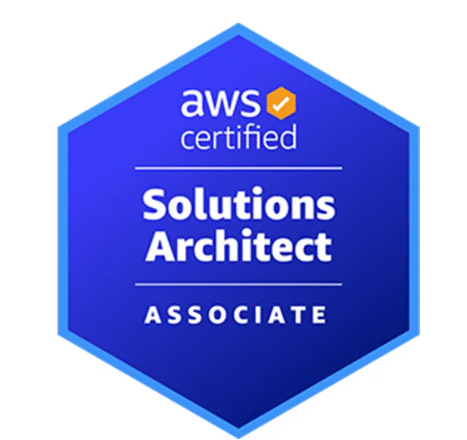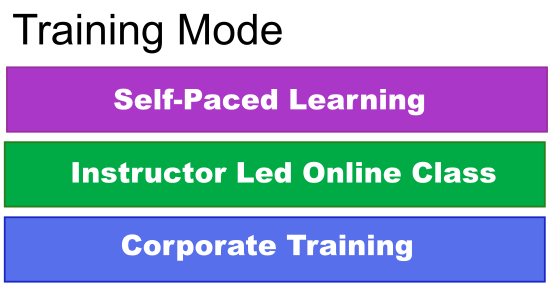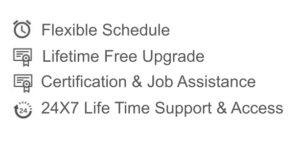
- Description
- Curriculum
COURSE OVERVIEW
We will get started with an introduction to the AWS Certified Solutions Architect certification. We will understand the basics of Regions and Availability Zones. We will discuss extensively EC2 service and Load balancing in AWS. You will learn to architect solutions for containers and container orchestration in AWS with AWS ECS, Fargate, and EKS. You will learn to architect serverless applications with Lambda and API Gateway. You will learn to Architect Your Private Network in AWS with VPC and Subnet.
After that, we move into Storage. We will look at the AWS services for Object Storage (Amazon S3), Block Storage (Elastic Block Storage EBS and Instance Store), and File Storage (EFS and FSx).
Choosing the right database is one of the main responsibilities of an architect. We will start with AWS services for Relational Databases – Amazon RDS and Amazon Aurora. We will look at Document Storage solutions offered by Amazon DynamoDB and Caching Solutions offered by Amazon ElastiCache.
In between, we explore solutions for Identity and Access Management in AWS (IAM), Encryption (KMS and Cloud HSM), and Monitoring (AWS CloudTrail, CloudWatch, and Config).
We will help you design asynchronous applications in AWS with SQS, SNS, and MQ. You will learn to architect AWS solutions for Content Distribution with Amazon CloudFront and Routing with Route 53.
You will learn to choose services for streaming data (Amazon Kinesis Data Streams, Data Firehose and Analytics) and Big Data (RedShift and EMR).
We will end the course by taking a look at how you can get ready for your AWS Certified Solutions Architect Associate exam.
COURSE HIGHLIGHTS
-
Introduction – AWS Certified Solutions Architect
-
Getting Started – AWS Certified Solutions Architect
-
Getting started with AWS Virtual Servers – EC2 Service and EC2 Instances
-
Take care of Billing in the Cloud
-
Getting Started with Load Balancing in AWS – Elastic Load Balancing
-
EC2 and ELB for AWS Architects
-
Getting started with AWS Elastic Beanstalk
-
Getting Started with Containers in AWS – ECS, Fargate, and EKS
-
Serverless with AWS Lambdas and API Gateway
-
Create Your Private Networks in AWS with VPC and Subnet
-
Getting Started with Amazon S3 – Object Storage in AWS
-
Getting Started with IAM – Identity and Access Management in AWS
-
Data Encryption in AWS with KMS and Cloud HSM
-
Block Storage in AWS – Elastic Block Storage EBS and Instance Store
-
Getting Started with File Storage – EFS and FSx
-
Getting Started with AWS Storage Gateway
-
Getting Started with Databases
-
Getting Started with RDS – Relational Databases in AWS
-
Getting Started with Amazon DynamoDB
-
Getting Started with Amazon ElastiCache
-
Exploring AWS CloudTrail, CloudWatch and Config
-
Asynchronous Communication with SQS, SNS, and MQ
-
Content Distribution with Amazon CloudFront
-
Getting Started with Route 53 – AWS Domain Registrar and DNS
-
Getting Started with AWS Data Lakes
-
More Serverless in AWS
-
Connecting AWS with On-Premise Data Centers
-
Moving Data from On-Premises to AWS
-
DevOps in AWS
-
More AWS Services
-
Getting Ready for AWS Certified Solutions Architect
-
Practice Test – AWS Certified Solutions Architect Associate
-
6Why Cloud Computing is Good for Organizations as well as an Individuals
-
7Why Cloud Computing is Good for Organizations as well as an Individuals
-
8Advantages of Cloud Computing
-
9Advantages of Cloud Computing
-
10Well-Architected Framework Discussion
-
11Well-Architected Framework Discussion
-
12Amazon Global Infrastructure :::Amazon Regions and AZs
-
13Amazon Global Infrastructure :::Amazon Regions and AZs
-
14EC2 Instances Launch Types
-
15EC2 Instances Launch Types
-
20Amazon S3 Buckets and Objects
-
21Amazon S3 Buckets and Objects
-
22Consistency Model in Amazon S3
-
23Consistency Model in Amazon S3
-
24Amazon S3 Use cases
-
25Amazon S3 Use cases
-
26Amazon S3 Access Control
-
27Amazon S3 Access Control
-
28Amazon S3 Security & Bucket Policies
-
29Amazon S3 Security & Bucket Policies
-
30Amazon S3 Versioning
-
31Amazon S3 Versioning
-
32How to Move Data To Amazon S3?
-
33Can I Speed Up My Upload :: Multipart Upload
-
34Can I Speed Up My Upload :: Multipart Upload
-
35Amazon S3 Encryption
-
36Amazon S3 Encryption
-
37Amazon Transfer Accelerator
-
38Amazon Transfer Accelerator
-
39Amazon Snowball
-
40Amazon Snowball
-
41Amazon Snowball edge
-
42Amazon Snowball edge
-
43Amazon Snowball mobile
-
44Amazon Snowball mobile
-
45Amazon S3 Use cases:: When to Use and When Not To Use
-
46Amazon S3 Use cases:: When to Use and When Not To Use
-
47Amazon S3 Glacier
-
48Amazon S3 Cost
-
49Amazon S3 Glacier Archive and Valuts
-
50Amazon S3 Glacier
-
51Cost to Move data to Amazon Glacier
-
52Amazon S3 Glacier Archive and Valuts
-
53Amazon S3 storage classes Discussion
-
54Cost to Move data to Amazon Glacier
-
55How to Choose a Region ?
-
56Amazon S3 storage classes Discussion
-
57How to Choose a Region ?
-
64What is a Compute Layer ?
-
65What is a Compute Layer ?
-
66Amazon Machine Image (AMI) and Ec2 Discussion
-
67Amazon Machine Image (AMI) and Ec2 Discussion
-
68How AMI Help the Organizations ?
-
69How AMI Help the Organizations ?
-
70How to Build AMI Image
-
71How to Build AMI Image
-
72EC2 AMI Hands On
-
73EC2 AMI Hands On
-
74Cross Account AMI Copy
-
75Launching an Amazon Ec2 Instance with user Data
-
76Launching an Amazon Ec2 Instance with user Data
-
77Meta Information Discussion
-
78Meta Information Discussion
-
79Amazon EC2 and Storing Data on It
-
80Amazon EC2 and Storing Data on It
-
81Amazon EBS Introduction
-
82Amazon EBS Introduction
-
83Amazon EBS Volume Types
-
84Amazon EBS Volume Types
-
85EBS Operation: Snapshots
-
86EBS Operation: Snapshots
-
87EBS Operation: Volume Encryption
-
88EBS Operation: Volume Encryption
-
89Shared File System ::: EBS / S3 / FSX
-
90EBS vs Instance Store
-
91Amazon Elastic File System
-
92Shared File System ::: EBS / S3 / FSX
-
93Amazon FSx
-
94Amazon Elastic File System
-
95AMAZON EC2 and Instance TYPES
-
96Amazon FSx
-
97AMAZON EC2 Instance Types
-
98AMAZON EC2 and Instance TYPES
-
99AMAZON EC2 and Instance Sizes
-
100Discussion About Naming Convention
-
101Instances generation and cost
-
102AMAZON EC2 Instance Types
-
103AMAZON EC2 and It's Pricing Option
-
104AMAZON EC2 and Instance Sizes
-
105OnDemand Instances
-
106Instances generation and cost
-
107Reserved Instances
-
108AMAZON EC2 and It's Pricing Option
-
109Dedicated Hosts
-
110OnDemand Instances
-
111Reserved Instances
-
112Dedicated Hosts
-
118Examples of High Availability
-
119Multi-Region High Availability and DNS
-
120Amazon Route 53
-
121How Does Route 53 Help with High Availability?
-
122Route 53 Routing Options
-
123Routing Policy - Simple round robin
-
124Routing Policy - Weighted round robin
-
125Routing Policy - Latency-based routing
-
126Route 53 Health Checks
-
127Routing Policy - Failover
-
128Routing Policy - Geolocation routing & Geoproximity routing with traffic biasing
-
129Routing Policy - Multi Value answers
-
136Factors Affecting High Availability
-
137Discussion on Elasticity & Types of Elasticity
-
138Monitoring
-
139Why Monitoring is a Need
-
140Monitoring Infrastructure with Amazon CloudWatch
-
141Discussion on The Ways CloudWatch Responds
-
142Monitoring Your Users with AWS CloudTrail
-
143Monitoring Your Network with VPC Flow Logs
-
144Scaling Your Architecture to Gain Elasticity
-
145Discussions on Various Ways to Auto Scale
-
146Scaling our Databases
-
147Horizontal Scaling with Read Replicas: Amazon RDS
-
148Aurora DB Cluster
-
149Aurora Serverless
-
150Scaling Amazon RDS Writes with Database Sharding
-
151Scaling DynamoDB
-
152DynamoDB Adaptive Capacity
-
157Tightly Coupled vs Loosely Coupled Systems
-
158Why Decoupling is Required ?
-
159Decoupling with Amazon SQS
-
160Amazon Simple Queue Service (Amazon SQS)
-
161Queue Types
-
162Amazon SQS - Standard Queue Hands & Amazon SQS - FIFO Queues
-
163SQS General Use Cases
-
164Amazon SQS Features
-
165Amazon SQS - Message Visibility Timeout
-
166Amazon SQS - Dead Letter Queues
-
167Amazon SQS - Delay Queues
-
168Amazon SQS Message Lifecycle
-
169Messaging Use Cases
-
170Decoupling with Amazon SNS
-
171Amazon Simple Notification Service (Amazon SNS)
-
172Amazon SNS Subscription Types
-
173General Use Cases for Amazon SNS & its Characteristics
-
174Achieving Loose Coupling with Amazon SNS and Amazon S3
-
175How is Amazon SNS Different from Amazon SQS?
-
176• Developing with Amazon MQ
-
177High Availability and Durability in Message Queue
-
178When To Use MQ vs SQS or SNS
-
179Amazon RDS Overview
-
180Amazon RDS Overview
-
181Amazon RDS and Amazon Aurora
-
182Amazon RDS Use Cases
-
183Amazon RDS Use Cases
-
184Amazon DynamoDB
-
185Amazon DynamoDB
-
186Data Distribution: Partition Key and Sort Key
-
187Data Distribution: Partition Key and Sort Key
-
188Amazon DynamoDB Has Global Tables
-
189Amazon DynamoDB Has Global Tables
-
190Consistency Options for Amazon DynamoDB
-
191Use Cases of Amazon DynamoDB
-
192How to Migrating Data into Your AWS Databases:: AWS DMS
-
193Consistency Options for Amazon DynamoDB
-
194Using AWS Snowball Edge with AWS DMS
-
195Security Controls for Amazon RDS and DynamoDB
-
196How to Migrating Data into Your AWS Databases:: AWS DMS
-
197Migration Options:: OneTime vs Ongoing
-
198Using AWS Snowball Edge with AWS DMS
-
199How Schema can be Converted using AWS Schema Conversion Tool
-
200Disaster Planning--What to PLan ?
-
201RPO and RTO
-
202Essential AWS Services and Features for Disaster Recovery
-
203Storage Duplication for Recovery
-
204AWS Backup
-
205Networking Disaster Recovery Options
-
206Databases Should Be Backed Up and Redundant
-
207Use of Automation To Quickly Recover
-
208Examples of Backup and Restore
-
209Backing up On-Premises Data to AWS
-
210AWS Storage Gateway
-
211Use Case: Off-Site Backup Solution with Gateway-Stored Volumes
-
212Restore Backup To On-Premises Data Center: Gateway-Stored
-
213Backup and Restore
-
214Pilot Light Example
-
215Fully Working Low-Capacity Standby
-
216Multi-Site Active-Active
-
217Common Practices for Disaster Recovery on AWS
-
218Amazon Virtual Private Cloud (VPC)
-
219Amazon Virtual Private Cloud (VPC)
-
220Default VPC Overview
-
221Default VPC Overview
-
222Amazon VPC Specifics
-
223Deploying A VPC
-
224Deploying A VPC
-
225VPC and IP Addressing
-
226Multi-VPC Pattern & Multi-Account Pattern
-
227Subnet Overview
-
228VPC and IP Addressing
-
229Route Tables: Directing Traffic Between VPC Resources
-
230CIDR, Private vs Public IP
-
231Internet Gateways & Route Tables
-
232Subnet Overview
-
233NAT Instances
-
234Subnets: Key Attributes
-
235Subnet Use Case Examples
-
236Route Tables: Directing Traffic Between VPC Resources
-
237Elastic Network Interfaces
-
238Network Isolation by Subnets
-
239Private vs Public Address
-
240Internet Gateways & Route Tables
-
241Elastic IP Addresses
-
242NAT Instances
-
243Security in the Cloud
-
244NAT Gateways
-
245Security Groups
-
246Subnet Use Case Examples
-
247chaining of Security Groups
-
248Basic Subnet Configuration
-
249Network Access Control Lists (ACLs)
-
250Elastic Network Interfaces
-
251Directing Traffic To Your VPC
-
252Private vs Public Address
-
253Elastic IP Addresses
-
254Security in the Cloud
-
255Security Groups
-
256chaining of Security Groups
-
257Network Access Control Lists (ACLs)
-
258Multiple Layers of Defense for Your Infrastructure on Amazon Cloud
-
259Directing Traffic To Your VPC
-
260Re-Architecting
-
261How Do You Make an Architecture Loosely Coupled?
-
262How Do You Make an Architecture Loosely Coupled?
-
263Introduce an Amazon SQS Queue
-
264Introduce an Amazon SQS Queue
-
265How Can You Make This Architecture More Resilient?
-
266How Can You Make This Architecture More Resilient?
-
267What Type of Instance?
-
268What Type of Instance?
-
26910 Best Practices for Building Systems with AWS
-
27010 Best Practices for Building Systems with AWS
-
271High Availability on Networking Part
-
272High Availability on Networking Part
-
273How to Connect Networks in Amazon AWS
-
274How to Connect Networks in Amazon AWS
-
275Introduction of Virtual Private Gateway (VGW)
-
276Introduction of Virtual Private Gateway (VGW)
-
277Extending On-Premises Network to AWS: VPN Connections
-
278Extending On-Premises Network to AWS: VPN Connections
-
279Extending On-Premises Network to AWS: Multiple VPN
-
280Peering Multiple VPCs
-
281AWS Direct Connect (DX)
-
282Connecting VPCs – Transit Gateway
-
283DX Use Cases
-
284Accessing VPC Endpoints from Outside the VPC
-
285Extending On-Premises Network to AWS: Using DX
-
286Load Balancing on AWS
-
287AWS Direct Connect Resiliency for Critical Workloads
-
288Why You Should Use ELB ?
-
289How to Connect 2 or More VPCs
-
290Classic Load Balancer (CLB) with
-
291VPC Peering
-
292Network Load Balancer (NLB) with Hands On
-
293Peering Multiple VPCs
-
294Elastic Load Balancer - Stickiness
-
295Connecting VPCs – Transit Gateway
-
296Elastic Load Balancer - Cross Zone Load Balancing
-
297VPC Endpoints & its Types
-
298Accessing VPC Endpoints from Outside the VPC
-
299What is AWS PrivateLink
-
300Load Balancing on AWS
-
301Elastic Load Balancing (ELB)
-
302Why You Should Use ELB ?
-
303Cloud Design Pattern: Application Load Balancer
-
304Classic Load Balancer (CLB) with
-
305Application Load Balancer (ALB) with Hands On
-
306Network Load Balancer (NLB) with Hands On
-
307Elastic Load Balancer - Stickiness
-
308Elastic Load Balancer - Cross Zone Load Balancing
-
309Examples of High Availability
-
310Multi-Region High Availability and DNS
-
311Amazon Route 53
-
312How Does Route 53 Help with High Availability?
-
313Route 53 Routing Options
-
314Routing Policy - Simple round robin
-
315Routing Policy - Weighted round robin
-
316Routing Policy - Latency-based routing
-
317Route 53 Health Checks
-
318Routing Policy - Failover
-
319Routing Policy - Geolocation routing & Geoproximity routing with traffic biasing
-
320Routing Policy - Multi Value answers
-
321What is User Account and IAM ?
-
322Organizing My Users
-
323AWS Identity and Access Management
-
324Discussion on IAM User Group
-
325Discussion on IAM Principals
-
326Security Token Service (STS)
-
327Understanding IAM Users
-
328Identity Federation & Cognito Discussion
-
329IAM Permissions
-
330Directory Services - Overview
-
331Identity-Based Policy vs Resource-Based Policies
-
332AWS Landing Zone
-
333IAM Policy Example
-
334AWS Recommendations for Managing Multiple Accounts
-
335Organizing My Users
-
336Discussion on IAM User Group
-
337Discussion on Federating Users:: Assume a Role
-
338Security Token Service (STS)
-
339SAML Discussion
-
340Identity Federation & Cognito Discussion
-
341Directory Services - Overview
-
342AWS Landing Zone
-
343Multiple Accounts
-
344AWS Recommendations for Managing Multiple Accounts
-
345AWS Organizations
-
346Factors Affecting High Availability
-
347Discussion on Elasticity & Types of Elasticity
-
348Monitoring
-
349Why Monitoring is a Need
-
350Monitoring Infrastructure with Amazon CloudWatch
-
351Discussion on The Ways CloudWatch Responds
-
352Monitoring Your Users with AWS CloudTrail
-
353Monitoring Your Network with VPC Flow Logs
-
354Scaling Your Architecture to Gain Elasticity
-
355Discussions on Various Ways to Auto Scale
-
356Scaling our Databases
-
357Horizontal Scaling with Read Replicas: Amazon RDS
-
358Aurora DB Cluster
-
359Aurora Serverless
-
360Scaling Amazon RDS Writes with Database Sharding
-
361Scaling DynamoDB
-
362DynamoDB Adaptive Capacity
-
363What is Automation and Why it is Needed?
-
364How to Automate Your Infrastructure
-
365How Automation Does Work?
-
366Infrastructure as Code (IaC) and its Benefits.
-
367AWS OpsWorks for Infrastructure and Deployment Automation
-
368Lifecycle Events for OpsWorks Stacks
-
369Using AWS OpsWorks Stacks with AWS CloudFormation
-
370AWS Elastic Beanstalk
-
371What Should I Cache?
-
372How Caching Works in Amazon CloudFront
-
373Types of Caching For Your Architecture
-
374How to Configure CloudFront
-
375Caching On AWS
-
376Discussion on Caching Your Web Tier
-
377Content Delivery Network (CDN)
-
378Session Management
-
379Amazon CloudFront
-
380Caching Your Database
-
381How Caching Works in Amazon CloudFront
-
382When Using DynamoDB for State Information
-
383How to Configure CloudFront
-
384Amazon DynamoDB Accelerator
-
385Discussion on Caching Your Web Tier
-
386When Using DynamoDB for State Information
-
387Session Management
-
388How Does It Work?
-
389When Using DynamoDB for State Information
-
390Redis and Memcached
-
391Caching Your Database
-
392When Should You Start Caching Your Database?
-
393When Using DynamoDB for State Information
-
394Amazon DynamoDB Accelerator
-
395When Using DynamoDB for State Information
-
396Amazon ElastiCache
-
397How Does It Work?
-
398Redis and Memcached
-
399AWS Cloud Architecture: Web Hosting
-
400Tightly Coupled vs Loosely Coupled Systems
-
401Why Decoupling is Required ?
-
402Decoupling with Amazon SQS
-
403Amazon Simple Queue Service (Amazon SQS)
-
404Queue Types
-
405Amazon SQS - Standard Queue Hands & Amazon SQS - FIFO Queues
-
406SQS General Use Cases
-
407Amazon SQS Features
-
408Amazon SQS - Message Visibility Timeout
-
409Amazon SQS - Dead Letter Queues
-
410Amazon SQS - Delay Queues
-
411Amazon SQS Message Lifecycle
-
412Messaging Use Cases
-
413Decoupling with Amazon SNS
-
414Amazon Simple Notification Service (Amazon SNS)
-
415Amazon SNS Subscription Types
-
416General Use Cases for Amazon SNS & its Characteristics
-
417Achieving Loose Coupling with Amazon SNS and Amazon S3
-
418How is Amazon SNS Different from Amazon SQS?
-
419• Developing with Amazon MQ
-
420High Availability and Durability in Message Queue
-
421When To Use MQ vs SQS or SNS
-
422What Are Microservices?
-
423AWS Fargate
-
424Characteristics of a Microservice
-
425Benefits of Serverless Computing
-
426Containers
-
427Example: Amazon S3 and AWS Lambda for Order Processing
-
428Containers vs. Virtual Machines
-
429Amazon API Gateway
-
430Containers on Amazon EC2
-
431General Serverless Architecture Using API Gateway
-
432Amazon Elastic Container Service (Amazon ECS)
-
433AWS Step Functions
-
434Monolithic Application to Container-Based Microservices
-
435Monolithic to Container-Based Microservices
-
436AWS Fargate
-
437What Is Serverless Computing?
-
438AWS Lambda
-
439Benefits of Serverless Computing
-
440Example: Amazon S3 and AWS Lambda for Order Processing
-
441Amazon API Gateway
-
442General Serverless Architecture Using API Gateway
-
443AWS Step Functions
-
444Disaster Planning--What to PLan ?
-
445RPO and RTO
-
446Essential AWS Services and Features for Disaster Recovery
-
447Storage Duplication for Recovery
-
448AWS Backup
-
449Networking Disaster Recovery Options
-
450Databases Should Be Backed Up and Redundant
-
451Use of Automation To Quickly Recover
-
452Examples of Backup and Restore
-
453Backing up On-Premises Data to AWS
-
454AWS Storage Gateway
-
455Use Case: Off-Site Backup Solution with Gateway-Stored Volumes
-
456Restore Backup To On-Premises Data Center: Gateway-Stored
-
457Backup and Restore
-
458Pilot Light Example
-
459Fully Working Low-Capacity Standby
-
460Multi-Site Active-Active
-
461Common Practices for Disaster Recovery on AWS










